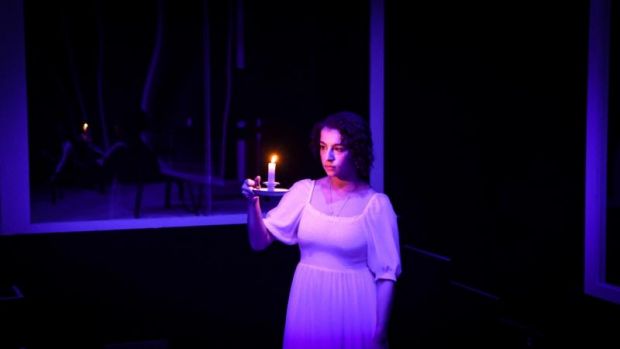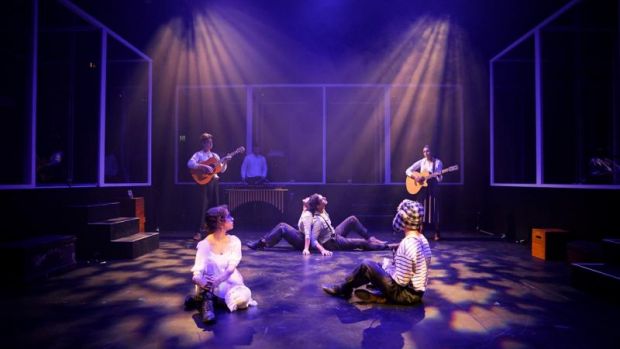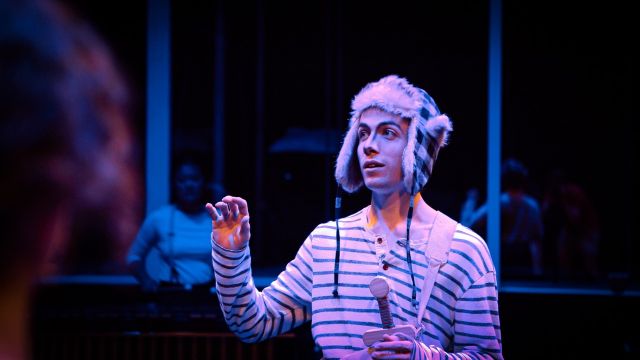The House on Fire at the Edge of the World
The House on Fire at the Edge of the World is the second music theatre show from WAAPA graduates Jackson Peele and Conor Neylon after their well-received The Beep Test. Here, we have a ‘contemporary folk music’ theatre piece that successfully combines various musical styles and a book that has elements of melodrama, fairy tale, magic realism, comedy, absurdity, whimsy and adventure all to create an epic journey for its protagonist.
A shy and vulnerable young woman, Elizabeth (Luisa Scrofani), is besieged with violence by the bullying local cop, The Lieutenant (Conor Neylon, one of the show’s creators): he demands that she marry him, or he will keep her only surviving family, her beloved uncle, in gaol and burn her house to the ground… unless, within five days, she can give him a star, a real star, from the heavens… Things look hopeless. But an awkward young faun, Klaus (Aiv Puglielli), still learning, appears and offers to guide Elizabeth to the edge of the world. There, he persuades her, she can find a star and save herself, her uncle and her home.

The show’s attractive, energetic, multi-cultural cast of actor-musicians engage us with a wonderful sense of cohesion and commitment – a true ensemble. Musicians put their instruments aside to becomes characters whom Elizabeth meets on her journey. These encounters are delightful in themselves, so much so that Elizabeth almost forgets the urgency of her quest even while growing as a human being at the same time. There is a fierce border guard (Kristie Nguy, who also plays mandolin, guitar, cajon and vibraphone), all too easily bribed, and two perpetually fighting soldiers, Guineth (Kaya Byrne – guitar, mandolin, cajon) and Seth (Miro Lauritz – vibraphone, glockenspiel, guitar). Both Mr Byrne and Mr Lauritz, incidentally, are enormously appealing and funny, with great stage presence. There’s a sailor (Mr Byrne again – but now sweet and touching) who sings of dancing with his true love with ‘two left feet’ – but it doesn’t matter. Elizabeth is swept up in a pre-harvest festival where she could be taken in by the warm, raucous community. Unfortunately, she also meets and, worse, falls in love with Simon (slightly confusingly Mr Neylon again), a roué and a thief…

Unusually, for a musical, many of the key songs are sung by the ensemble either as their various characters, or in a kind of choric function, led by Ahila Navaratnam rather than by the heroine Elizabeth or her companion, the Faun. Ms Navaratnam, on guitar, eerily externalises Elizabeth’s feelings as the spirit (perhaps?) of Elizabeth’s dead mother or her conscience. Elizabeth herself sings of what she has lost, her yearning and loneliness. If there’s a criticism of the singing, it’s that words get lost and it’s to do with diction: I’m sure the lyrics are as clever as the music. (Otherwise, this cast beats the acoustic problems of the Theatre Works boxes.) Meanwhile, the daunting bare playing space is constantly filled and enlivened by Zoee Marsh’s varied and inventive choreography, which the cast dances with precision and confidence – and comedy. At times there may be a little too much busy buzzing around the stage – especially by the Faun - but that is in pursuit of revealing the long journey and Klaus’s confusions and deceptions.
With all this accomplished musical, choreographic and acting talent on display, it’s unfortunate that what rather undercuts The House on Fire is its book. The creators call their show ‘experimental music theatre’, but I’m not sure quite what that means. Is The House on Fire permanently experimental or is it still in development? There is an intention in there somewhere, but Elizabeth’s and Klaus’s journey seems more an excuse to string together some musical and character ideas, good as they are.

The story begins as high melodrama and supplies the heroine with an impossible quest. But why is she suddenly so credulous? So that the story and the journey can begin, we have to accept a segue into what I can only call children’s theatre with the arrival of Klaus the faun. His magical abilities seem to be nil and his uncertainties are so pointed up as to be wearying that we wonder why Elizabeth trusts him for so long. Is there an echo of The Wizard of Oz here – a coherent tale with a disillusioning discovery for our heroine at the end of the journey?
We soon realise, even if Elizabeth does not, that Klaus has no idea where they are going and there might be no such place as ‘the edge of the world’ anyway. The story becomes a series of encounters – in themselves funny, entertaining and well-staged but not quite enough to stop us wondering, ‘where is all this going?’ Sadly, it’s not going anywhere: the journey runs out of steam. Unlike Dorothy in The Wizard of Oz, Elizabeth is a reactive character. Nor is she left with the realisation that ‘there’s no place like home’ but with a devastation so dark and severe (even so, not resolving the melodramatic set-up) that the company of the unreliable, childish Klaus offers not much comfort.

In other words, what this potentially terrific show needs – as does any music theatre show – is a great book.
Watching the show, and enjoying so much of it, I was particularly struck by the ‘Two Left Feet’ number. (This interlude is the highlight of the show for me: Mr Byrne has a superb voice.) The song has a Sondheim-esque feel, and I was reminded of Sondheim and Lapine’s Into the Woods. That famous show also has – dare I say - a rather dissatisfying story per se, but the creators had the fairy tale characters we all know to rely on – and to turn on their heads - and a more substantial central thread and theme than Mr Neylon and Mr Peele have invented for themselves here.
Michael Brindley

Subscribe to our E-Newsletter, buy our latest print edition or find a Performing Arts book at Book Nook.

